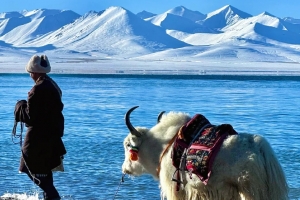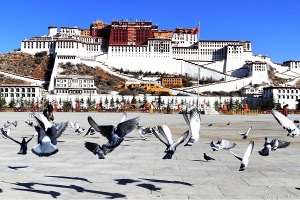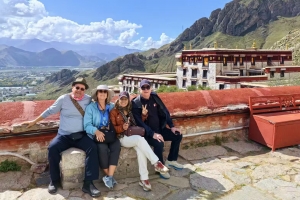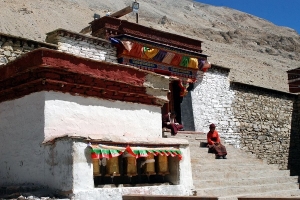Traveling to Tibet is more than ticking a destination off your bucket list – it’s a transformative journey across landscapes, cultures, and altitude. While flying gets you to Lhasa quickly, taking the Qinghai–Tibet Railway turns every hour into part of the adventure. Journey2tibet can help you plan and book every step of this route – from tickets to on-ground transfers and acclimatization itineraries.
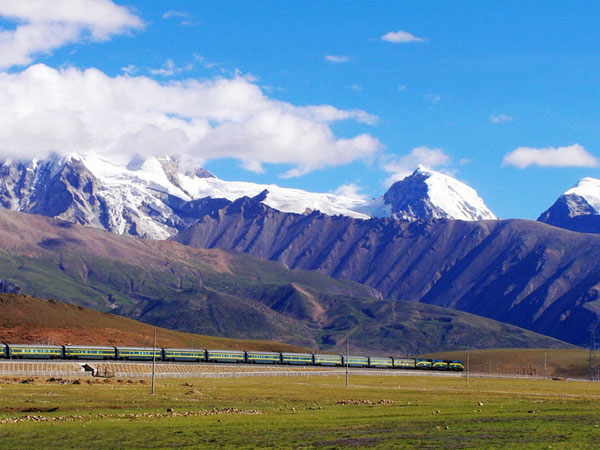
Qinghai–Tibet Train
1) Train travel is budget-friendly — save on transport, spend on experiences
Compared with long-haul flights, the Qinghai–Tibet Railway is usually much cheaper. For travelers who prefer to allocate more of their budget to local guides, cultural activities, and comfortable lodgings on the plateau, the train offers excellent value. Costs remain relatively stable across seasons compared with flight fares, which can spike during holidays. That said, train seats and sleepers do sell out fast during summer and around national holidays — booking early is essential.
2) Spectacular, ever-changing highland scenery right outside your window
Few journeys in the world offer such continuous, dramatic scenery as the Qinghai–Tibet line. From the rolling grasslands and yak pastures to shimmering lakes and distant snow-capped peaks, the landscape unfolds like a living panorama. Key photo opportunities commonly appear on the Qinghai-to-Lhasa stretch; if you want the best light, plan to be at the window during daylight hours and keep your camera ready.
3) Gradual altitude gain gives your body a gentler acclimatization
A major advantage of arriving by train is the slower ascent to high altitude. Rather than jumping from sea level to over 3,500 meters within hours (as with many flights), the rail trip takes 20–50+ hours depending on your starting point, allowing your body to adjust more gradually. This can reduce the severity of acute mountain sickness symptoms like headaches, nausea, and shortness of breath. Trains are also equipped with oxygen systems and basic medical support for added peace of mind.
4) Direct rail links from major Chinese cities make multi-stop itineraries easy
The Qinghai–Tibet Railway connects with many of China’s travel hubs. That means you can combine city sightseeing (Beijing, Chengdu, Xi’an, etc.) with a scenic rail approach to Tibet. For international visitors who want a mix of urban culture and high plateau immersion, the train lets you design flexible, layered itineraries: a few days in a big city, then a relaxed train journey into the plateau.

Qinghai–Tibet Railway Route Map
5) The train is a social, cross-cultural space — meet people and swap stories
Long-distance trains naturally foster conversation. You’ll likely share the carriage with domestic travelers, local Tibetans, and international visitors — a lively environment for exchanging tips, learning about Tibetan customs, and getting insider suggestions that guidebooks miss. The communal nature of the journey often produces memorable encounters and spontaneous travel companions.
6) Multiple berth and seating options to suit different budgets and comfort needs
Qinghai–Tibet trains offer a range of accommodation classes: hard seats, hard sleepers, and soft sleepers. Soft sleepers are the most comfortable (better privacy and bedding), hard sleepers balance cost and comfort, while hard seats are the most economical. For long overnight runs, sleepers are strongly recommended for rest and a better acclimatization experience. Trains also provide dining cars and basic wash facilities to cover essential needs during the journey.
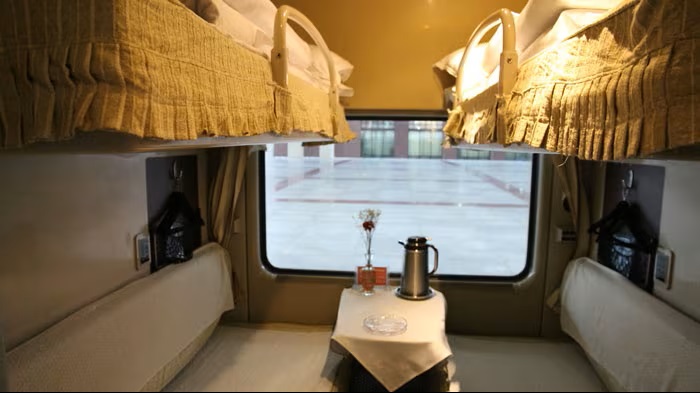
Soft sleeper on the Qinghai-Tibet Railway
7) Built for the plateau — safety systems and medical support on board
The railway and rolling stock serving the plateau are engineered with high-altitude conditions in mind. Many trains have supplemental oxygen available, and staff are trained to respond to altitude-related issues. Routine maintenance and specific design adaptations help ensure stable operation even in extreme environments, giving passengers a reliable means of travel across remote regions.
8) Lower carbon footprint — a more environmentally considerate choice
Train travel generally produces less carbon per passenger than air travel. Choosing the train helps reduce the environmental impact of your trip, an important consideration when visiting fragile ecosystems such as the Tibetan Plateau. Travelers who care about sustainability often prefer rail over flying for this reason.
9) The journey itself becomes part of your Tibet story
Perhaps the most intangible but powerful reason to take the train is that the journey shapes your experience. The gradual changes in landscape, the rhythm of station stops, the communal meals and conversations — these are the moments that often become the emotional highlights of a trip. The train is not just transport; it’s a moving capsule of discovery that prepares you mentally and spiritually for the places you will visit.
Practical tips for international travelers taking the Qinghai–Tibet Railway
- Book early in peak season. Summer and holiday periods sell out quickly.
- Choose an appropriate berth. Soft sleepers cost more but are worth it on long runs.
- Pack for variable temperatures. Highland days can be mild while nights are cold. Layering is essential.
- Bring hydration and medications. Water, gentle analgesics, and any altitude meds you’ve been advised to take.
- Respect local customs. Be mindful when photographing religious sites and local ceremonies.
- Prepare entertainment & snacks. Long stretches can be quiet; bring reading material, music, and light snacks.
- Limit heavy activity immediately upon arrival. Rest and let your legs and lungs adjust gradually.
Sample Qinghai–Tibet Railway Ticket Prices (Reference)
Below is a reference table of typical ticket prices for common departure cities to Lhasa. Prices are illustrative and quoted in Chinese Yuan (CNY). Actual fares vary by date, train type, and availability; always confirm on the official booking platform or through your travel agent.
| From → Lhasa | Approx. Travel Time | Hard Seat (¥) | Hard Sleeper (¥) | Soft Sleeper (¥) | Notes |
|---|---|---|---|---|---|
| Beijing → Lhasa | ~40–41 hours | ¥360 | ¥720 | ¥1,144 | Popular long-haul route — book early in high season |
| Shanghai → Lhasa | ~44–46 hours | ¥402.5 | ¥793.5 | ¥1,262.5 | Some long Z-train services on this corridor |
| Guangzhou → Lhasa | ~53 hours | ¥447 | ¥865 | ¥1,468 | One of the longest single-route services |
| Chengdu → Lhasa | ~34–36 hours | ¥302.5 | ¥627.5 | ¥997.5 | A frequent choice for southwest travelers |
| Xining → Lhasa | ~20–21.5 hours | ¥224 | ¥495 | ¥781 | Shorter segment on the Qinghai–Tibet line |
Important: These numbers are provided as a general guide only. Train classes, seasonal surcharges, and platform-specific fees can influence final prices. Journey2tibet can verify current fares and help you secure sleepers and preferred berths.
How Journey2tibet can help
Journey2tibet specializes in tailor-made Tibet travel. We can:
- Check and reserve train tickets (soft/hard sleepers or seat classes) based on your dates and comfort needs.
- Arrange airport or train-station pick-ups and drop-offs in Lhasa.
- Design acclimatization-friendly itineraries (slow ascent, rest days, gentle activities).
- Book reliable local guides and cultural visits that respect local traditions.
- Provide 24/7 support while you travel on the plateau.
Booking through an experienced operator like Journey2tibet saves time and reduces stress — especially for first-time visitors who prefer local support with language, logistics, and health considerations.
Sample two-day acclimatization plan after arriving in Lhasa
- Day 1 (Arrival / Rest): Short, calm walk near your hotel (no steep climbs). Hydrate, avoid alcohol, and sleep early.
- Day 2 (Light Exploration): Visit Jokhang Temple and Barkhor Street at a relaxed pace; keep exertion low. Consider a short, guided city tour to learn cultural basics without straining.
Gradual exposure helps your body adapt and allows you to enjoy the main sites (Potala Palace, monasteries, lakes) in better condition.
Make the train part of the adventure
If your travel style values scenic immersion, steady acclimatization, and cultural encounters, the Qinghai–Tibet Railway should be high on your list. The train enriches the journey to Tibet in ways a quick flight simply can’t match: it gives you time to watch the plateau unroll, to rest into higher altitudes, and to meet people whose stories may become part of your own.
When you’re ready to plan, Journey2tibet is here to assist — from ticketing and transfers to customized, health-conscious itineraries that let you experience Tibet safely and meaningfully. Reach out and let us create a rail-first adventure that suits your interests and comfort level.
Recommended itinerary for the Qinghai-Tibet Railway:

